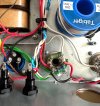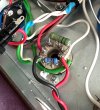Some comments:It’s wired in now . Couldn’t fit it In the hole but rested it between them will this be okay?
View attachment 157979
Also wired in the indicator light it’s not pretty but should be fine?
Also twisted the green wires to make it look neater
View attachment 157982
View attachment 157980View attachment 157981
- 10k/3W resistor will probably work, but I usually make a narrow "U" on one lead that will go around the lead from the 470R (for mechanical support).
- You have surrounded the V5 socket with heater wires. It is better to rout them on one side, to minimize hum. Don't know how sensitive the power amp sockets are, though.
- Is p1 on V4/5 connected to ground? Can't see any solder there.
- Lamp wires (AC) are routed in same bundle as OT primaries (to V4/5p3). I would separate them, and try to cross at 90° instead.
- Also, looks like you need to clean the sockets, to avoid shorting between lugs. Important!



















